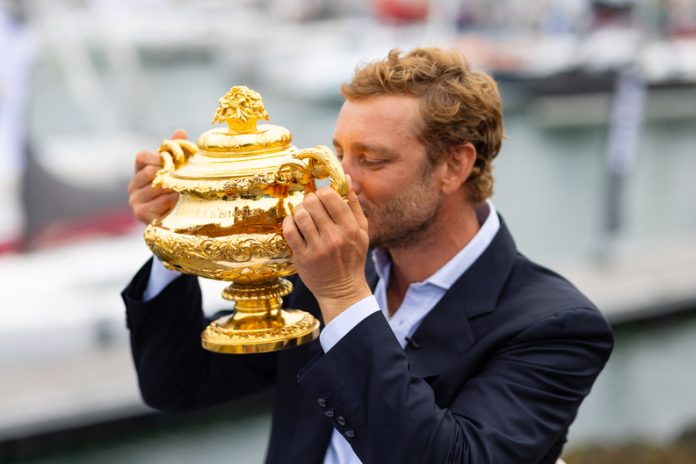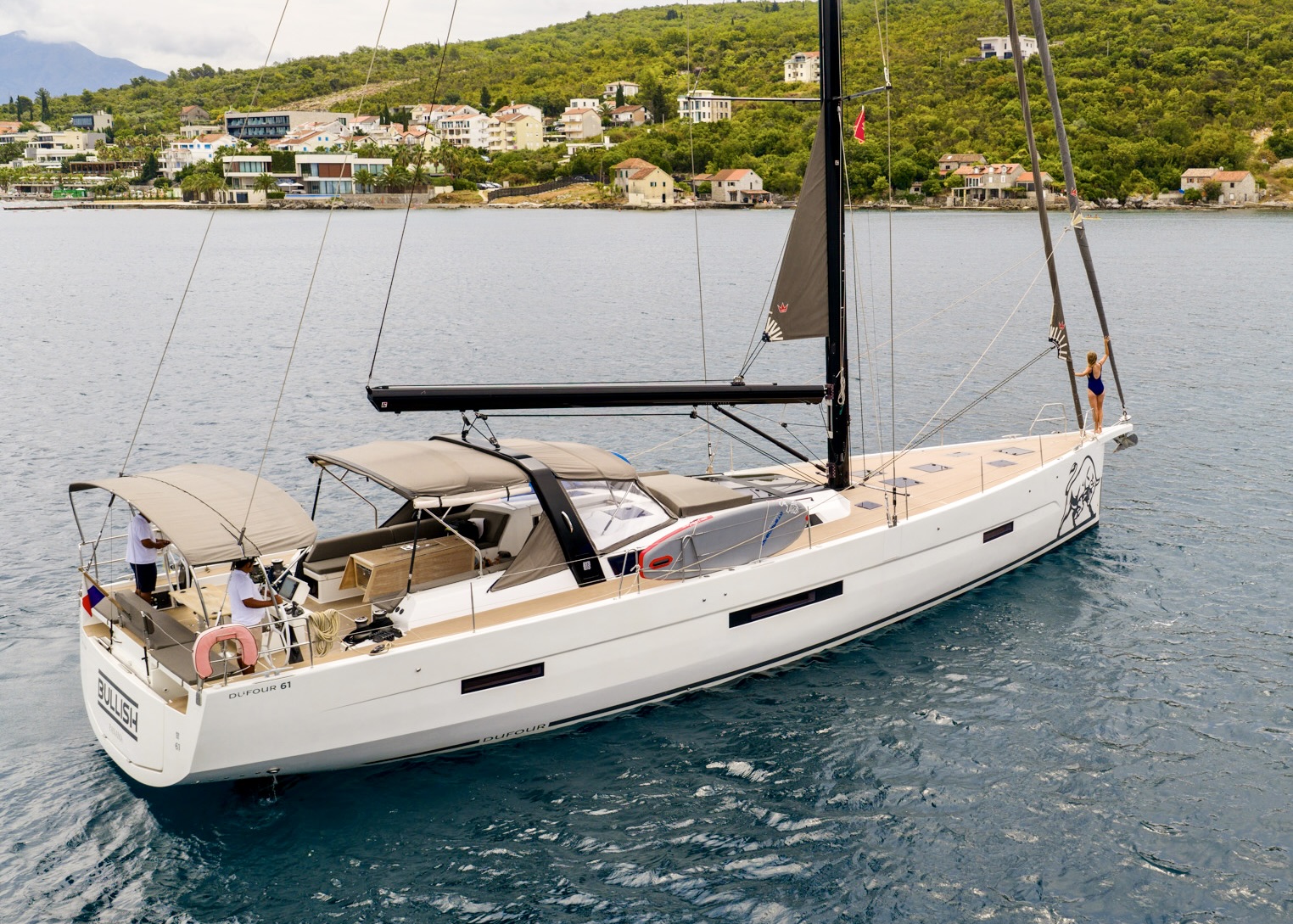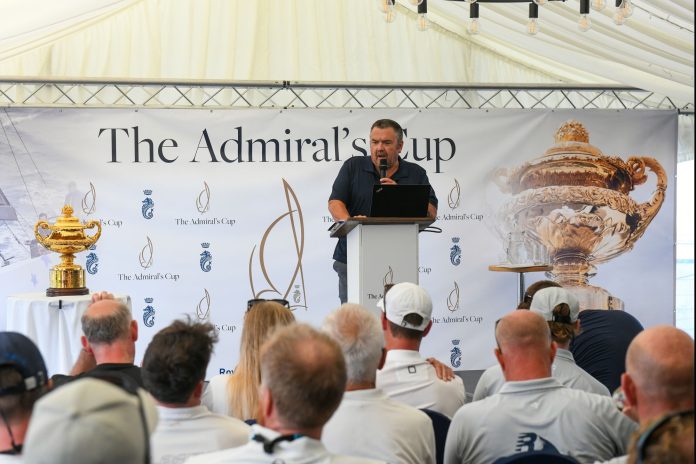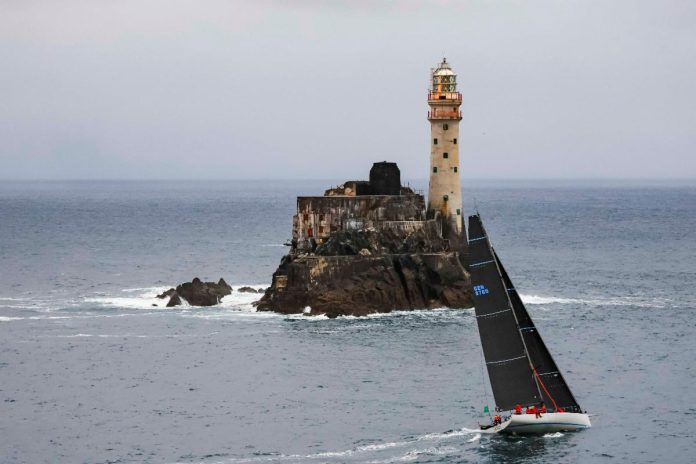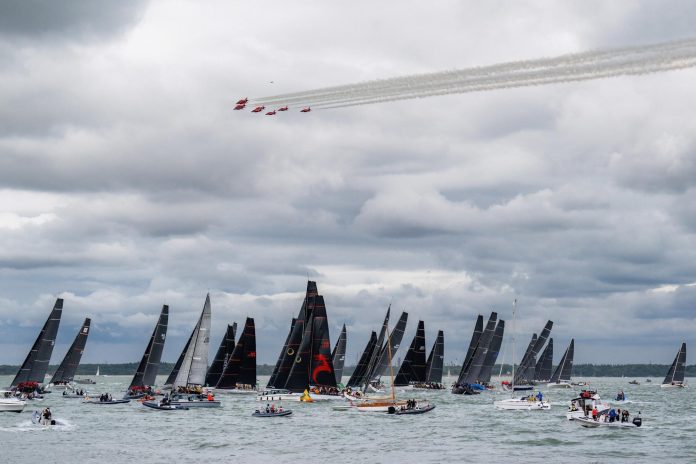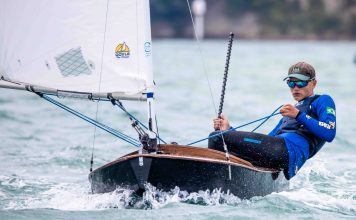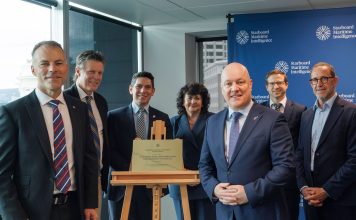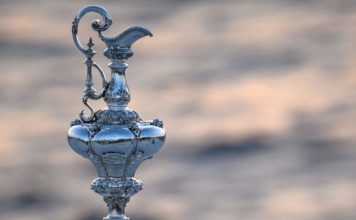This was Monaco’s moment
They came to Cowes with pedigree, precision—and a plan. Yacht Club de Monaco hadn’t entered the Admiral’s Cup before 2025, but they left no doubt about their intentions. Sailing Jolt 3 in AC Class 1 and Jolt 6 in AC Class 2, the team delivered a clean, consistent campaign that led to overall victory in the Cup’s long-awaited return.
Jolt 3, a Botin-designed TP52 owned by Peter Harrison and skippered by Matt Adams, was the team’s points engine. Their inshore performance was razor-sharp: 2nd in Race 2, back-to-back wins in Races 3 and 4, and another 2nd in Race 5. With three podiums and just one deep finish (9th), they entered the Fastnet with margin and nerve. A 21st in that offshore classic might have derailed lesser campaigns, but Monaco held their course.
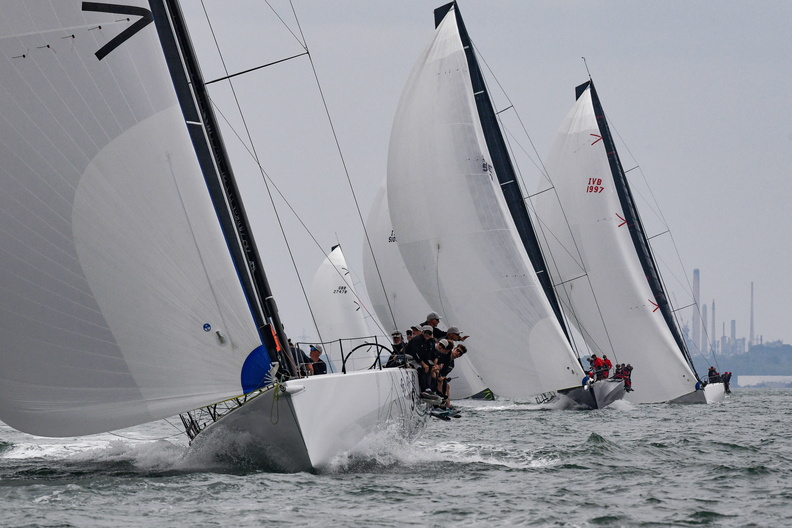
RORC Admiral’s Cup 24 July 2025
// Photo credit: Rick Tomlinson/RORC
Jolt 6, a Carkeek 40 Mk2, was every bit as vital. Helmed by Tom Dawson, the crew included young Kiwi Oakley Marsh—a graduate of the RNZYS Mastercard YTP. Jolt 6 stayed in the fight through the inshore series, but it was their 3rd in the Fastnet that sealed the Class 2 win and the team’s overall title. Their 28 points was the lowest score in either class.
With veterans like Ed Baird, Cameron Dunn, Stacey Jackson, Andy Green, and Kiwi offshore legend Robbie Naismith spread across both boats, Harrison and co-leader Pierre Casiraghi assembled one of the deepest crews in the fleet. It showed.
This wasn’t a flashy campaign. It was professional, patient, and quietly dominant. Monaco’s first Admiral’s Cup appearance became its first outright win. For a club better known for Riviera regattas, this was something else entirely—a gritty, full-blooded offshore triumph.
The return of the Admiral’s Cup
First raced in 1957, the Admiral’s Cup was conceived as a national team event by the Royal Ocean Racing Club (RORC), with each country fielding a trio of top offshore yachts. Hosted from Cowes on the Isle of Wight, the format blended short-course inshore racing with long-distance offshore legs, culminating in the Rolex Fastnet Race—a 600-mile classic rounding Fastnet Rock off Ireland’s southwest coast.
At its height, over a dozen nations competed, including the UK, USA, Australia, France, Germany and New Zealand. New Zealand won in 1987, while Australia claimed the 2003 edition—the last until now.
After more than two decades away, the 2025 Admiral’s Cup returned to mark RORC’s centenary. But this wasn’t just nostalgia. With two-boat teams, a diverse global entry list, and the Fastnet back in the mix, the format felt refreshed. The start line was international again. For many sailors, this edition was a long-awaited shot at a title their mentors once fought for.
A global line-up of teams, boats and big names
Fifteen teams, thirty boats, and hundreds of sailors descended on Cowes for the 2025 Admiral’s Cup. Each team fielded a pairing of two yachts: one larger Class 1 offshore boat, and one high-performance Class 2 racer. The format struck a balance between ocean miles and inshore manoeuvring, testing every facet of modern racing.
Teams flew the flags of their home yacht clubs: RNZYS, CYCA, RHKYC, RORC, YCCS, and others from the USA, Netherlands, Germany, Ireland, and Monaco. Some were returning after decades; others arrived for the first time with serious intent.
The fleet ranged from TP52s and Ker 46s to Fast 40s and modified Cape 31s—each chosen for all-round capability. Kiwi, European, and Australian boats blended offshore nous with racecourse agility.
With no discard and two-boat scoring, consistency was everything. One tactical error or torn sail could sink a campaign. That pressure made every start, every shift, and every mile count.
Picking favourites for the 2025 Admiral’s Cup is a deeply dangerous game
Hong Kong nearly stole the show
Finishing second overall, Royal Hong Kong Yacht Club proved what many offshore sailors already knew: Beau Geste is a legacy. Owner Karl Kwok has spent decades building elite teams, and this year’s pairing of Beau Geste (TP52) and Beau Ideal (Fast 40) was no exception.
Beau Geste opened with a 4th in the Channel Race and stayed solid through the inshore legs. A tough Fastnet knocked them out of class contention, but the crew—including Gavin Brady, Wade Morgan, and Olympic medallist Nick Rogers—sailed with cohesion and composure. Kwok, now 50 years a member of RHKYC, helmed with trademark calm.
Beau Ideal was the closer. With podiums in five of the first six races and a 3rd in Class 2 overall, it kept the team in the hunt. Onboard were some of New Zealand’s sharpest offshore sailors: Dave Swete, Nick Egnot-Johnson, and Ryan Houston.
For RHKYC, second overall was no fluke. This was a campaign built on trust, teamwork, and the quiet confidence of a well-oiled machine.
Costa Smeralda brought an unexpected twist
Based in Porto Cervo, Sardinia, Yacht Club Costa Smeralda is best known for superyacht regattas and the Azzurra TP52. But in 2025, they brought their own challenge north to Cowes—and nearly stole the show.
Django WR51, their Class 1 Wally Rocket 51 skippered by Giovanni Lombardi Stronati, opened with a 2nd in the Channel Race and won Race 8. Steady finishes throughout earned 4th in Class 1.
Django JPK (JPK 11.80) took longer to fire, but improved late—posting a 2nd, 3rd, and a strong Fastnet to finish 4th in Class 2. Together, the boats secured 3rd overall.
Their shared crew included Olympic sailors and grand prix pros: Vasco Vascotto, Guille Parada, Chris Hosking, and Bruno Zirilli. Quietly effective, YCCS proved that Italian sailing is about far more than flair.
Team RNZYS returns
The Royal New Zealand Yacht Squadron returned to the Admiral’s Cup with two serious campaigns. Caro, a Botin 52 skippered by Max Klink, featured Celia Willison, James Paterson, and Justin Ferris among a crew loaded with offshore pedigree. A tough Channel Race and a brutal Fastnet result left them 8th in Class 1.
Callisto, the Hakes-built GP42 skippered by James Murray, was sharper. With Mike Sanderson, Dean Barker, James Dagg, and PG de Felice aboard, the team delivered wins in three inshore races and finished 2nd in Class 2. Their 12th in the Fastnet was just enough to hold that spot.
It wasn’t a perfect regatta, but it marked New Zealand’s return to a competition it once won outright. And it showed the depth of Kiwi offshore talent—in both generations.
Australia’s fight
The Cruising Yacht Club of Australia brought a heavyweight Class 1 contender in Zen, Gordon Ketelbey’s TP52. With Chris Nicholson, Tom Addis, and Tom Barker aboard, they scored 2nd overall in class. Zen was consistent, composed, and tough when it counted.
Back to Black, a modified GP42 co-skippered by Sean Langman and Josh Alexander, had a harder time. The crew included Gordon Maguire and rising talent Lincoln Dews, but the Fastnet leg hurt them badly. They finished 8th in Class 2.
Zen delivered. Back to Black struggled. But as a combined team, Australia still brought the grit that made them champions in decades past.
A game of pairs
The two-boat format exposed a clear truth: no passengers. Monaco won because both Jolt 3 and Jolt 6 delivered. Hong Kong leaned more heavily on Beau Ideal, while Beau Geste held steady. Costa Smeralda’s Django WR51 carried the points load, but Django JPK’s late recovery mattered.
New Zealand and Australia flipped the script—Callisto and Zen excelled, while their partners faltered. At this Cup, balance was everything.
The 2025 Admiral’s Cup was a reset. It took one of offshore sailing’s great trophies and gave it relevance again. The two-boat format allowed teams to blend tradition and innovation. The racing was real: tough, technical, and no-frills. The message was clear; offshore team racing is back.
“The Forgotten Cups”? Why offshore racing is stealing the spotlight








